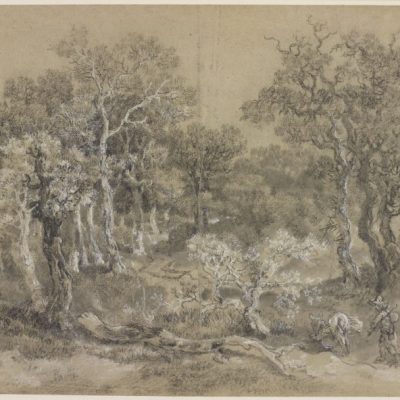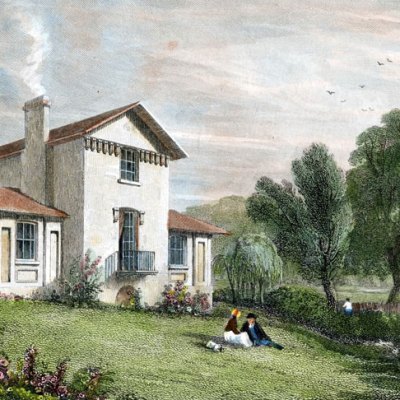Thomas Gainsborough was not only a sweet painter, but also a sweet talker. As a boy, he persuaded his schoolmaster to let him off lessons to go sketching in the country. ‘Give Tom a holiday,’ wrote the schoolmaster in a note for Gainsborough to take to his father.
Tom, seeing an opportunity, carefully copied the master’s handwriting 50 times and hid the forgeries in a warming pan to be dipped into throughout the summer, whenever he fancied playing hooky with his chalks. He didn’t think the warming pan would be used until the autumn, but someone in the house was ill – he was the youngest of eight siblings – and when the pan was unhooked, a cascade of notes fell out. ‘Tom will one day be hanged,’ his father said. But when he saw the drawings his son had made in the woods around Sudbury, he changed his tune: ‘Tom will be a genius.’
This is the Thomas Gainsborough (1727–88) his friends and early biographers wanted us to have: the dreamy child of nature, somewhere between a faun and a Fotherington-Thomas. The warming pan story, says James Hamilton in his fast-paced biography, Gainsborough: A Portrait (Weidenfeld & Nicolson), is almost certainly a myth. Hamilton’s Gainsborough is a ‘Jack-the-Lad’, a ‘swigging, gigging, kissing, drinking, fighting’ good-time city boy in London and Bath. But not a debauchee or a fool. Gainsborough is an artist ‘alert to the main chance’: a canny subletter of properties; a man who married a woman – Margaret, the illegitimate daughter of the Duke of Beaufort – with a settlement of £200 a year; and an adaptable flatterer of his sitters. ‘He talked bawdy to the King, and morality to the Prince of Wales,’ said the painter Francis Bourgeois of Gainsborough’s success with George III and the royal family.
He was a friend of David Garrick and James Quin and must himself have been a convincing actor. No lord, lady or parson could have doubted his admiration, but on bad days he resented portrait painting. Portraiture was ‘the curs’d Face Business’, with its parade of ‘confounded ugly creatures’. That is Gainsborough in one of his ‘growls’. There may have been the odd ugly earl or baronet, but more often there was the pleasure of hours in a candlelit studio – Gainsborough lit his rooms dimly, with Caravaggesque candles, the better to set off the shimmer of silk and pale, powdered necks – with a Mary Howe (in pink dress and summer hat), a Mary Graham (ostrich feathers) or a Penelope Ligonier (white satin, tasselled sash).
The passage most often quoted from Gainsborough’s letters is this: ‘I’m sick of Portraits and wish very much to take my Viol da Gam and walk off to some sweet Village where I can paint Landskips and enjoy the fag End of Life in quietness & ease.’ Previous biographers have used this as evidence that Gainsborough would have devoted himself to landscape if he hadn’t needed the ‘curs’d Face Business’ to pay the bills. Hamilton puts Gainsborough’s words in context. In the same letter he writes of having been ‘flung’ – ‘told to get lost’ in Hamilton’s update – by a Miss Floud in Bath with whom he’d been flirting. The ‘sweet village’ fantasy isn’t so much a case of an artist thwarted in his true calling, as a man nursing his wounded amour propre.
Gainsborough was susceptible to beautiful women. The teenage Tom was an assistant in Francis Hayman’s London studio, a place where, according to one contemporary, a boy ‘could learn little of painting and less of morality’. The streets of London, wrote Gainsborough, were ‘my first school, and deeply read in petticoats I am’.
In later life, a trip to London from Bath, where he had his studio (painting patrons who were up for the season to take the waters), always caused trouble. In 1763, Gainsborough was treated for some sort of venereal disease, picked up in the capital. When he came home, two of the city’s smartest doctors were called, but none of their treatments did him as much good as his daughter Mary’s prescription of ‘six glasses of good, old Port’. That broke the fever. In his forties, Gainsborough moved his studio to London where he had to restrain himself from ‘enjoying what I like up to the Hilt’.
Hamilton gives us Gainsborough the ‘lad’, out with his ‘mates’, painting the occasional ‘bombshell’. Of Vauxhall Pleasure Gardens, the popular nightspot south of the Thames, Hamilton writes: ‘What happened in Vauxhall, stayed in Vauxhall.’ While this makes for a lively telling, there is a sense sometimes of straining to be ‘down with the kids’. This, though, is the smallest quibble with a biography that otherwise gallops along at highwayman’s pace – Gainsborough was once held up by highwaymen half a mile beyond Hammersmith and robbed of his pocket watch and two guineas – through the life, art, and times of its subject, as well as the cities and the countryside of the 18th century.
Hamilton, whose previous books include Turner: A Life (1997) and A Strange Business: Making Art and Money in Nineteenth-Century Britain (2014), is strong both on the Gainsborough who is stirred by harvest gleaners and woodland cottages, and the Gainsborough who frets about his framing fees and boasts about the musical instruments he has bought: ‘My comfort is, I have 5 Viol’s da Gamba, 3 Jayes, and two Barak Normans.’ This, writes Hamilton, is like a star of the art world today saying: ‘“My comfort is, I have 5 Lamborghinis, 3 Ferraris and two Aston Martins.” Their value as status symbols is broadly similar.’
On his deathbed, Gainsborough worried that he had not put enough aside for Margaret and the girls. Mrs Gainsborough soothed him. Only now did she reveal that for the 42 years of their marriage, knowing how ‘he always threw his money about, leaving it at the mercy of every one,’ she had stowed away £10,000 in savings. That explained it. Gainsborough had always been ‘puzzled’ about why he worked so hard, and earned so much, and never had a bill in a pocket. Dazzling painter. Inconstant man. Clever wife.
From the October 2017 issue of Apollo. Preview and subscribe here.



